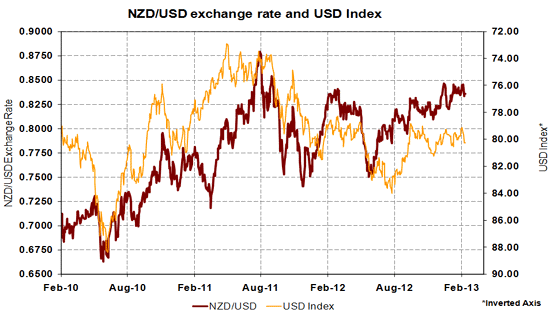
 By Roger J Kerr
By Roger J Kerr
Until there is a change of direction and sentiment in global equity markets, it is hard to see what is going to drive the Kiwi dollar down to the bottom end of its long-established 0.8100 to 0.8500 trading range.
The single most significant positive factor for the NZ dollar since 1 January has been the “risk on” mode or appetite from global investors as they happily buy the “growth/commodity” currency when world sharemarkets go up.
The strong performance of equities, so far, in 2013 does not appear to be too strongly linked to global economic growth suddenly looking a whole lot better.
Most forecasters have downgraded global growth forecasts over recent weeks.
The positive investor sentiment has come from a perceived reduction in investment/financial market risk as the US Fiscal Cliff situation turned out to be not the catastrophe it was earlier feared.
Likewise in Europe, the statements from ECB head Mario Draghi that financial market risk had decreased in response to the ECB liquidity measures taken over the second half of 2012, buoyed the markets.
However, as has been commented on in recent days, Europe is still in deep recession economically even if market risk has dropped.
The simple fact for the Kiwi dollar is that we have not had a sharp pull-back below 0.8000 for more than seven months as we have not had a European financial market blow up that scares global sharemarkets.
At the end of the day, underlying economic performances still do determine relative exchange rate movements, however shorter-term investor sentiment forces can and do over-ride the fundamentals for long periods. Not that investor sentiment is negative for New Zealand, the demand for last week’s inaugural inflation-linked Government bond tenders was six times oversubscribed with strong offshore interest.
Looking ahead over coming weeks, whether the Dow Jones Index can decisively break through the 14,000 barrier and move higher, or alternatively commence a major correction down from recent gains, will determine the near term NZD/USD direction.
While offshore market developments have been behind all the Kiwi dollar movements higher over the last couple of months, it has been domestic economic data that has caused the sharp pull-backs e.g. two weaker but dodgy looking employment figures, weaker than expected GDP growth on Christmas Eve and low inflation results.
On the other hand, RBNZ Governor Wheeler has been consistent in delivering a more upbeat assessment on the economic outlook than what the market has expected and the Kiwi has always appreciated after RBNZ statements.
It is hard to see local economic data continuing to surprise on the downside over coming months with consumer and business confidence so positive and house prices increasing.
Therefore, the forces that do ultimately push the NZD/USD rate lower will centre on a weaker AUD and stronger USD generally in international forex markets.
Political, monetary and economic risks for the Australian dollar continue to build and are not positive for the currency in 2013.
On the US dollar front, the Fifty Billion Dollar question is “when do global FX markets start to price-in, in advance, the eventual withdrawal of monetary stimulus by the US Fed Reserve” ?
FX markets always price the future (even if it is 24 months away) into current exchange rates well in advance.
At some point this year, the NZD will be under downward pressure from general USD strength as the FX markets price the ultimate and inevitable increase in US short-term interest rates.
No-one knows when the markets will start this process; however the timing may be a lot earlier than what most currency analysts expect. It is going to be hard for the NZD/USD rate to stay above 0.8000 later in the year if the USD Exchange Rate Index is heading to 85.0 from the current 80.0 level.

The key US lead economic indicator for the likely FX market timing of lifting the USD’s value will be consistently strong monthly Non-Farm Payroll jobs increases.
We have already witnessed large revisions upwards in these jobs results for November, December and January.
Strong numbers for February, March and April as the climate improves for the house construction industry should see the timing of USD strength come forward somewhat.
My Kiwi mate, who is an architect in Florida, has his business is booming again from zero activity two year ago.
------------------------------------------------------------------------------------------------------------------------------
To subscribe to our daily Currency Rate Sheet email, enter your email address here.
------------------------------------------------------------------------------------------------------------------------------
Roger J Kerr is a partner at PwC. He specialises in fixed interest securities and is a commentator on economics and markets. More commentary and useful information on fixed interest investing can be found at rogeradvice.com
No chart with that title exists.

We welcome your comments below. If you are not already registered, please register to comment.
Remember we welcome robust, respectful and insightful debate. We don't welcome abusive or defamatory comments and will de-register those repeatedly making such comments. Our current comment policy is here.